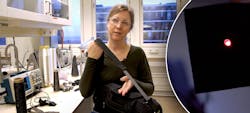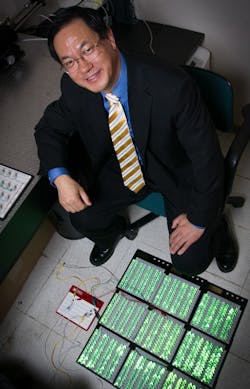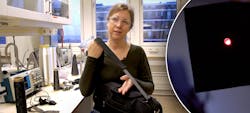Universities Develop Unique Methods for Generating Electricity
Last month, PET ran an article entitled “Generating Electricity is a Snap.” It covered a collaborative research project led by the University at Buffalo and the Institute of Semiconductors (IoP) at the Chinese Academy of Science (CAS) that uses a tab—a triboelectric nanogenerator. The Georgia Institute of Technology has also pursued similar studies. Chalmers University of Technology in Gothenburg, Sweden developed its own method of generating electricity, by stretching a fabric material.
Before describing the Chalmers University development, we’ll cover the work done at Georgia Tech where researchers discovered that certain materials hold a charge even after two surfaces separate. That information that could improve devices that leverage such energy as a power source.
“We’ve known that energy generated in contact electrification is readily retained by the material as electrostatic charges for hours at room temperature,” said Zhong Lin Wang, Regents’ Professor in the School of Materials Science and Engineering at Georgia Tech. “Our research showed that there’s a potential barrier at the surface that prevents the charges generated from flowing back to the solid where they were from or escaping from the surface after the contacting.”
In this research, which was reported in March in Advanced Materials, the researchers found that electron transfer is the dominant process for contact electrification between two inorganic solids and explains some of the characteristics already observed about static electricity (Fig.1).
1. Georgia Tech professor Zhong Lin Wang poses with an array of 1,000 LED lights that can be illuminated by power produced by the force of a shoe striking a triboelectric generator placed on the floor. (Credit: Rob Felt, Georgia Tech)
“There has been some debate around contact electrification—namely, whether the charge transfer occurs through electrons or ions and why the charges retain on the surface without a quick dissipation,” Wang said.
It’s been eight years since Wang’s team first published research on triboelectric nanogenerators, which employ materials that create an electric charge when in motion and could be designed to harvest energy from a variety of sources such as wind, ocean currents, or sound vibrations.
“Previously we just used trial and error to maximize this effect,” Wang said. “But with this new information, we can design materials that have better performance for power conversion.”
The researchers developed a method using a nanoscale triboelectric nanogenerator—composed of layers either of titanium and aluminum oxide or titanium and silicone dioxide—to help quantify the amount of charge accumulating on surfaces during moments of friction.
The method was capable of tracking the accumulated charges in real time and worked over a wide range of temperatures, including very high ones. The data from the study indicated that the characteristics of the triboelectric effect—namely, how electrons flowed across barriers—were consistent with the electron thermionic emission theory.
By designing triboelectric nanogenerators that could withstanding testing at high temperatures, the researchers also found that temperature played a major role in the triboelectric effect.
“We never realized it was a temperature dependent phenomenon,” Wang said. “But we found that when the temperature reaches about 300ºC, the triboelectric transfer almost disappears.”
The researchers tested the ability for surfaces to maintain a charge at temperatures ranging from about 80 to 300°C. Based on their data, the researchers proposed a mechanism for explaining the physics process in triboelectrification effect.
“As the temperature rises, the energy fluctuations of electrons become larger and larger,” the researchers wrote. “Thus, it is easier for electrons to hop out of the potential well, and they either go back to the material where they came from or emit into air.”
This work was supported by the Hightower Chair Foundation, the National Key R & D Project from the Minister of Science and Technology of China, the National Natural Science Foundation of China and the Six Talent Peaks Project in Jiangsu Province, China.
Chalmers University Research
2. Anja Lund with a piece of the electric textile in the shoulder strap of a bag (the lighter-colored part). To the right: a LED that flashes because electricity is generated when the textile is stretched.
Researchers at Chalmers University of Technology have developed a fabric that converts kinetic energy into electric power, in cooperation with the Swedish School of Textiles in Borås and the research institute Swerea IVF. The greater the load applied to the textile and the wetter it becomes the more electricity it generates. The results are published in the Nature Partner journal Flexible Electronics (22 March).
Chalmers researchers Anja Lund and Christian Müller have developed a woven fabric that generates electricity when it is stretched or exposed to pressure. The fabric can currently generate enough power to light an LED, send wireless signals, or drive small electric units such as a pocket calculator or a digital watch (Fig. 2).
The technology is based on the piezoelectric effect, which results in the generation of electricity from deformation of a piezoelectric material, such as when it is stretched. In the study the researchers created a textile by weaving a piezoelectric yarn together with an electrically conducting yarn, which is required to transport the generated electric current.
“The textile is flexible and soft and becomes even more efficient when moist or wet,” Lund said. “To demonstrate the results from our research we use a piece of the textile in the shoulder strap of a bag. The heavier the weight packed in the bag and the more of the bag that consists of our fabric, the more electric power we obtain. When our bag is loaded with 3 kilos of books, we produce a continuous output of 4 µW. That’s enough to intermittently light an LED. By making an entire bag from our textile, we could get enough energy to transmit wireless signals.”
The piezoelectric yarn is made up of 24 fibers, each as thin as a strand of hair. When the fibers are sufficiently moist, they become enclosed in liquid and the yarn becomes more efficient, since this improves the electrical contact between the fibers. The technology is based on previous studies by the researchers in which they developed the piezoelectric fibers, to which they have now added a further dimension.
“The piezoelectric fibers consist of a piezoelectric shell around an electrically conducting core,” Lund said. “The piezoelectric yarn in combination with a commercial conducting yarn constitute an electric circuit connected in series.”
Previous work by the researchers on piezoelectric textiles has so far mainly focused on sensors and their ability to generate electric signals through pressure sensitivity. Using the energy to continuously drive electronic components is unique.
“Woven textiles from piezoelectric yarns makes the technology easily accessible, and it could be useful in everyday life,” Lund said. “It’s also possible to add more materials to the weave or to use it as a layer in a multi-layer product. It requires some modification, but it’s possible.”
The researchers consider that the technology is, in principle, ready for larger-scale production. It is now mainly up to industrial product developers to find out how to make use of it. Despite the advanced technology underlying the material, the cost is relatively low and is comparable with the price of Gore-Tex. Through their collaboration with the Swedish School of Textiles in Borås, the researchers have been able to demonstrate that the yarn can be woven in industrial looms and is sufficiently wear-resistant to cope with the harsh conditions of mass production.
The textile consists of piezoelectric yarns woven together with electrically conducting yarns. A piezoelectric yarn is made up of 24 fibers each as thin as a strand of hair, with each fiber having an electrically conducting core surrounded by an insulating and piezoelectric polymer. During manufacture the fabric is exposed to a high electric field, which causes positive and negative charges in the polymer to be separated in an orderly manner. When the textile is then stretched or exposed to pressure, the deformation of the fibers causes a reorganization of the charge distribution, thus generating an electrical voltage. The electrically conducting yarn is required to form a closed circuit through which an electric current can flow.
Piezoelectric Effect
The piezoelectric effect allows a material to generate an electrical voltage when it is exposed to pressure or stretching. Piezoelectricity is a result of a displacement of the charge distribution in the material due to deformation, and can be found in biological materials such as bone, protein, and DNA, and also in other types of materials such as ceramics, plastics, and textiles.
The textile research was funded by the Swedish Foundation for Strategic Research (SSF), the Knut and Alice Wallenberg Foundation, and the European Research Council (ERC).
About the Author

Sam Davis
Sam Davis was the editor-in-chief of Power Electronics Technology magazine and website that is now part of Electronic Design. He has 18 years experience in electronic engineering design and management, six years in public relations and 25 years as a trade press editor. He holds a BSEE from Case-Western Reserve University, and did graduate work at the same school and UCLA. Sam was the editor for PCIM, the predecessor to Power Electronics Technology, from 1984 to 2004. His engineering experience includes circuit and system design for Litton Systems, Bunker-Ramo, Rocketdyne, and Clevite Corporation.. Design tasks included analog circuits, display systems, power supplies, underwater ordnance systems, and test systems. He also served as a program manager for a Litton Systems Navy program.
Sam is the author of Computer Data Displays, a book published by Prentice-Hall in the U.S. and Japan in 1969. He is also a recipient of the Jesse Neal Award for trade press editorial excellence, and has one patent for naval ship construction that simplifies electronic system integration.
You can also check out his Power Electronics blog.



